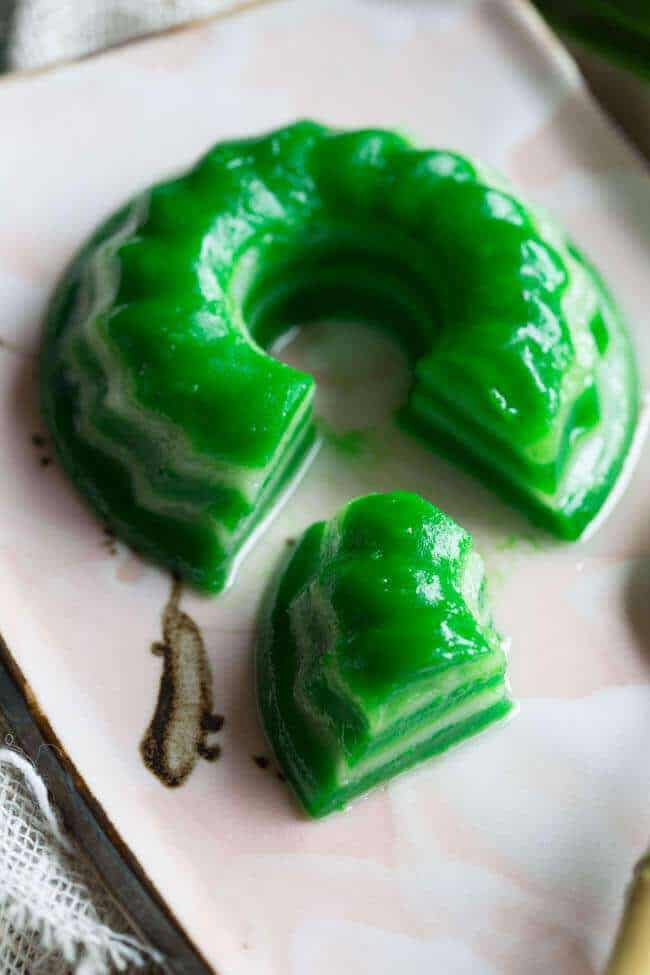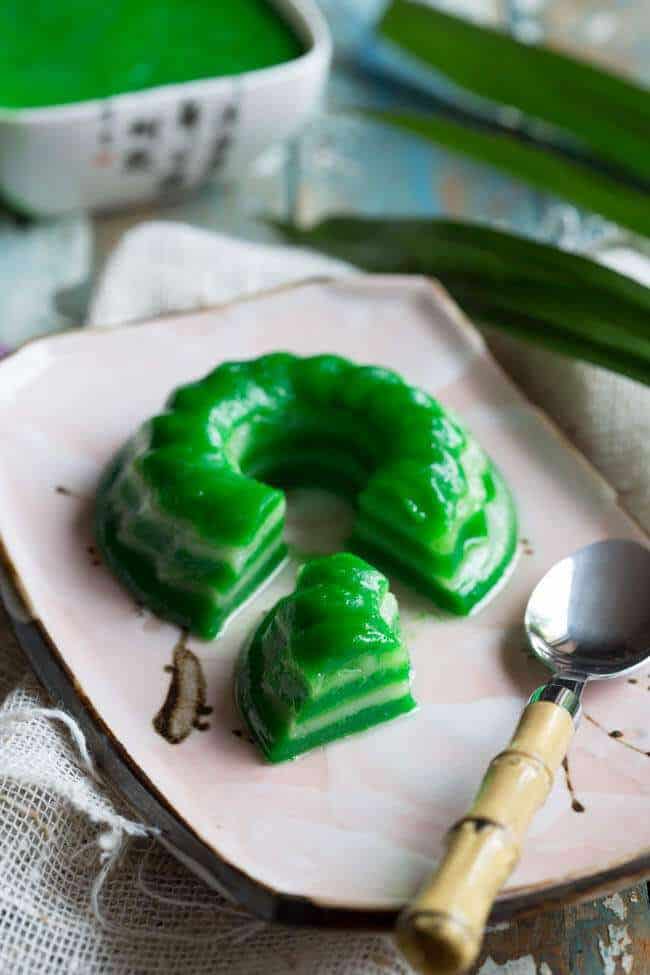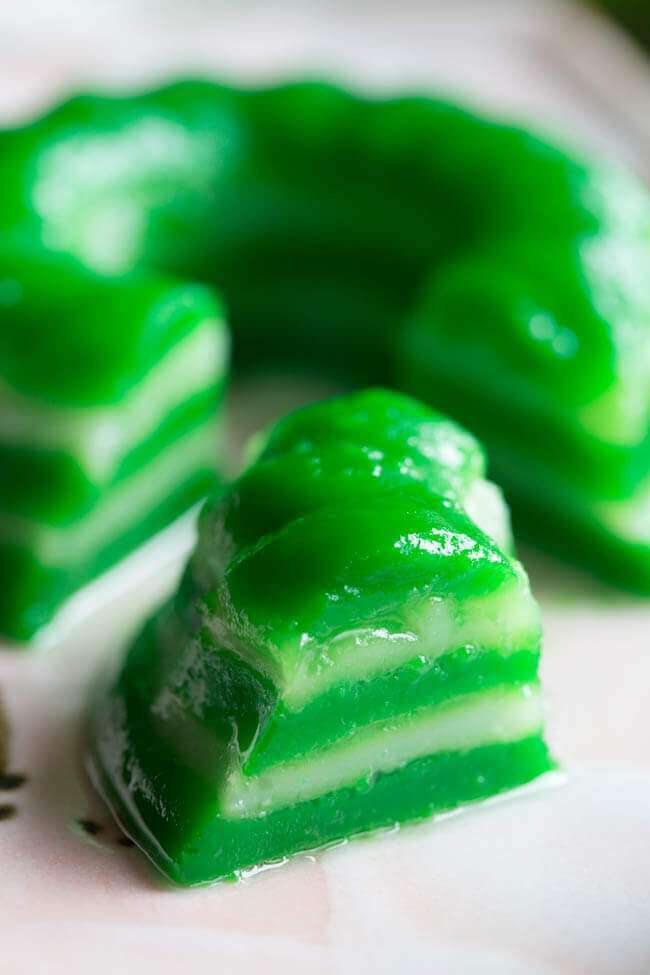Steamed Indonesian cake kue lapis recipe
This traditional Indonesian steamed cake goes by the name of kue lapis and is bright green and in layers. It’s a mix somewhere between a cake and a pudding and has a lovely coconut flavor due to the use of coconut milk.

Kue lapis recipe
Obviously I am not Indonesian but I do have a friend who is and we made this traditional cake together. It is closely related to the layered cake also known as thousand layer cake, lapis legit or – as we call it here – spekkoek. While the latter is usually baked, kue lapis or kwee lapis is usually steamed. It can come in many different colors and for this particular version we chose to use pandan. I’ve seen pink versions as well, which looked pretty cool too. But we opted to use pandan leaves and pandan paste. The paste makes sure the color is actually green. The leaves give a lot of flavor but no color.
For making the kue lapis recipe you need some sort of mold that fits into the bamboo steamer. Or another kind of steam pan is also an option. I used small bundt tins I had on hand which worked out well. Do make sure you brush the tins well with a bit of oil or melted butter (obviously if you want to keep the recipe vegan do not use butter) to make sure they will turn out easily.
Making the batter for the kue lapis
Now making the cake batter for the kue lapis recipe is not complicated at all. You need to first dissolve the block of santen into a liter of water and let the pandan leaves infuse. Don’t let the mix boil as that is unnecessary. Let it cool down with the leaves in and tos the leaves after that.

Now taking a large bowl ad the rice flour, tapioca flour and the sugar into it and mix it well. Add it to your santen mix and keep stirring until you have a smooth mix. Divide mixture into two equal portions and add the green pandan paste to one part.
Steaming the cake
Now comes the part where you need to steam the cake. Place your steamer in a pan on high heat and make sure there is enough water level in the pan. I tend to use a large wok or large skillet so the bamboo steamer can sit easily inside the pan. Since you’re working in layers you first add a small amount of batter (the green one) as the first layer. Place it inside the steamer and steam for about 6 minutes before you add the second layer of the mixture. This should be a white layer. Continue with steaming the cake layer with subsequent layers until you get to the last layer. That is either because you run out of batter or because you’ve reached the top of your baking tin.

Serving the cake
Once you’ve finished your batter and baked the final layer let the cake cool down and then turn it out. It will have quite a bouncy texture and is probably unlike anything you’ve made before. Like I said it’s a mix between a regular cake and a pudding. Once you turn it out you should be able to see the distinct layers in different colors what makes this cake so unique. Obviously it matter how thin your layers are. Not for the taste but it does make a difference in terms of looks. It’s best to serve the kueh lapis legit in smaller pieces than you would normally serve a cake. It’s easiest to cut the cake with an oiled knife for best results and a clean cut.
If you’re into steamed cakes, also check this roti kukus.

Kue lapis
Ingredients
- 200 g santen coconut cream, in a block
- 1 liter water
- 4 pandan leaves
- 1/2 tsp salt
- 250 gr rice flour
- 50 gr tapioca flour they also call it tapioca starch
- 250 gr white sugar
- 30 ml pandan paste we used the one with artificial coloring, hence the green
- Put your block of santen into a liter of water and heat slowly while you let the pandan leaves infuse. Add 1/2 tsp of salt into it as well.
- Take of the heat (don’t let it boil) and leave to cool. Toss the pandan leaves.
- Put rice flour, tapioca flour and sugar in a bowl, mix this well and add to your santen mix. Stir until it is smooth and any lumps are gone. Divide into two separate quantities. Add the pandan paste to one half. Leave the other half white.
- Prepare a steamer and check that your cake tins (well greased) fit into the steamer. Bring water to the boil and start by adding a small layer of the green mix into the tin. Leave to steam for about 6 minutes and then follow with the next layer in a different color. Keep doing that until your mould is full or you run out of batter.
- Leave to cool and turn out onto a platter.
Nutrition Information per portion
Disclaimer
The nutritional values above are calculated per portion. The details are based on standard nutritional tables and do not constitute a professional nutritional advice.
